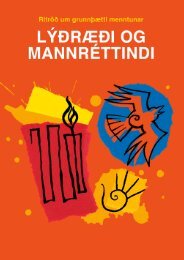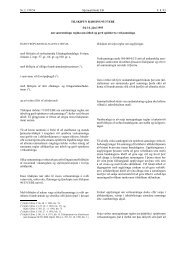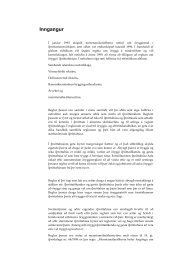Nomination of
Nomination of
Nomination of
You also want an ePaper? Increase the reach of your titles
YUMPU automatically turns print PDFs into web optimized ePapers that Google loves.
SURTSEY – NOMINATION FOR THE UNESCO WORLD HERITAGE LIST<br />
View to the west over the crater Surtungur. (Photo:<br />
Daníel Bergmann 2003).<br />
Tephra<br />
During the explosive submarine phase <strong>of</strong> the<br />
Surtsey eruption, from November 1963 to April<br />
1964, basalt tephra (volcanic ash) was produced<br />
through the quenching <strong>of</strong> hot magma by cold sea<br />
water. The resulting tephra formed two crescentshaped<br />
cones which merged, and today cover an<br />
area <strong>of</strong> 0.34 km 2 . The cones are built up <strong>of</strong> tephra<br />
layers which to a considerable extent have<br />
consolidated into tuff due to posteruptive<br />
hydrothermal activity. Geologists call craters <strong>of</strong><br />
this type tephra or tuff rings, depending on which<br />
material dominates. The eastern tuff cone, named<br />
Surtur or Austurbunki, has a crest-width <strong>of</strong> 0.43<br />
km, and the western tuff cone, Surtungur or<br />
Vesturbunki, has a crest-width <strong>of</strong> 0.52 km. On<br />
the scale <strong>of</strong> other Icelandic tuff or tephra craters,<br />
the Surtsey tuff craters are medium-sized.<br />
Characterised by poor sorting and varying<br />
grain size, Surtsey tephra ranges in its<br />
constituents from silt to boulders (Lorenz 1974),<br />
although it is mainly made up <strong>of</strong> fine glass shards<br />
less than 2 mm in diameter, along with mineral<br />
phenocrysts and small rock fragments. The tephra<br />
deposited above sea level forms finely-bedded<br />
layers and is poorly sorted, contrasting to the<br />
tephra below sea level, which is more chaotic in<br />
structure and whose grains sometimes demonstrate<br />
considerable size sorting. The porosity <strong>of</strong><br />
the tephra layers above sea level must rate as very<br />
high, or 45–50% by volume.<br />
Surtsey has come to be the world type locality<br />
18<br />
for Surtseyan tephra (Walker and Croasdale 1972;<br />
Walker 1973), i.e. tephra produced by hydromagmatic<br />
explosions in shallow water. The island<br />
is also an important site for accretionary lapilli<br />
(Sveinn P. Jakobsson and Moore 1982), whose<br />
individual pellets there reach the exceptional<br />
diameter <strong>of</strong> 3.5 cm. Also, Surtsey was one <strong>of</strong> the<br />
first localities in the world where vesiculated tuff<br />
was noted and described, i.e. tuff that contains<br />
independent vesicles between particles, where<br />
steam was trapped while the original tephra was<br />
being deposited (Lorenz 1974).<br />
Lava<br />
The Surtsey eruption evolved from an explosive<br />
phase into an effusive phase at the western crater<br />
(Surtungur) in April 1964, when the island was<br />
large enough to isolate that vent from inflowing<br />
seawater. Altogether, seven Surtsey craters and<br />
crater fissures emitted lava between April 1964<br />
and June 1967 (Fig. 2.6). The first major effusive<br />
phase (1964–1965) produced a lava shield<br />
extending 100 m above sea level and containing,<br />
when finished, a total volume <strong>of</strong> 0.3 km 3 , while<br />
the second phase (1966–1967) produced a 70-mhigh<br />
lava shield with a volume <strong>of</strong> 0.1 km 3 . Both<br />
<strong>of</strong> these shields consist <strong>of</strong> two structural units: an<br />
inner lava cone and an outer lava apron<br />
(Thorvaldur Thordarson 2000). Together they form<br />
a lava field that slopes gently to the south and<br />
east. Added to this are five small lava flows on the<br />
slopes <strong>of</strong> Austurbunki. Today the lavas cover an<br />
area <strong>of</strong> 0.72 km 2 .<br />
When lava flows into water it brecciates and<br />
gradually builds up a submarine delta in front <strong>of</strong><br />
the shore. Such a delta is foreset-bedded and<br />
consists <strong>of</strong> the products <strong>of</strong> the quenchfragmentation<br />
<strong>of</strong> molten lava and the<br />
disintegration <strong>of</strong> subaerial lava flows. At Surtsey<br />
the final layers in the western lava crater have<br />
achieved a total thickness <strong>of</strong> 230 m, resting on a<br />
130-m-thick brecciated foundation which lies<br />
below sea level.<br />
Due to heavy marine abrasion, high lava cliffs<br />
have formed on Surtsey and now tower a height<br />
<strong>of</strong> 80 m over the southwest shoreline. These cliffs<br />
provide excellent outcrops for viewing the internal<br />
structure <strong>of</strong> the subaerial lava shield, which was<br />
constructed by multiple lava flows whose thickness<br />
varies but averages 1–2 m. The morphology<br />
<strong>of</strong> the lava surface is very interesting, particularly



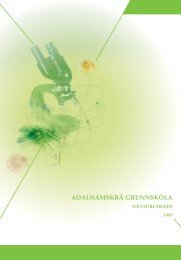
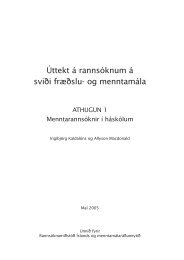


![Aðalnámskrá tónlistarskóla : rytmÃsk tónlist [Eingöngu á rafrænu formi]](https://img.yumpu.com/50843672/1/184x260/aaalnamskra-tanlistarskala-rytma-sk-tanlist-eingangu-a-rafranu-formi.jpg?quality=85)
